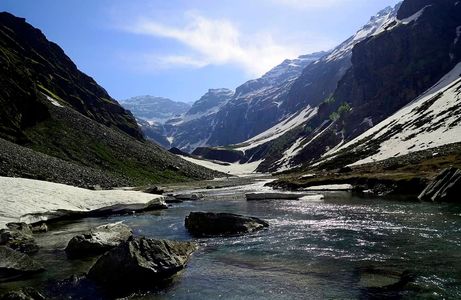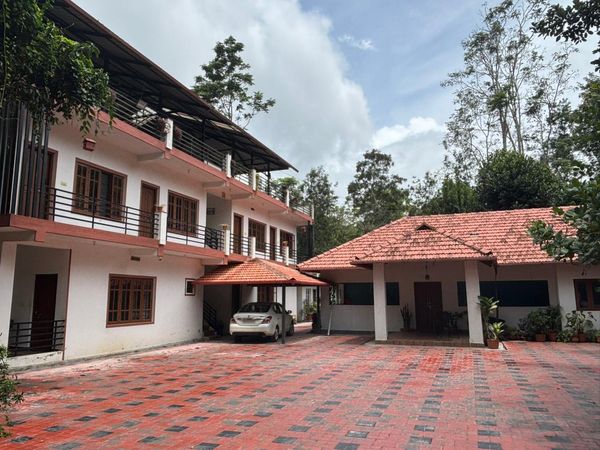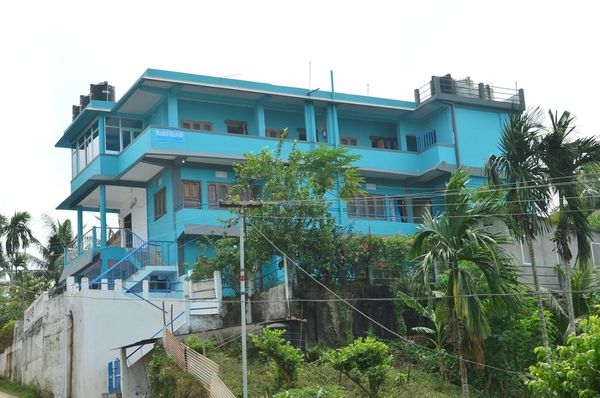Rupin Pass Trek: A Thrilling Himalayan Expedition
 Rohit Sen
30 Jan, 2025
8 mins read
2
Rohit Sen
30 Jan, 2025
8 mins read
2

If you crave an adventure that challenges your endurance while rewarding you with spectacular views, the Rupin Pass Trek is for you. This high-altitude trek offers diverse landscapes, cultural experiences, and thrilling trails, making it a must-do for trekking enthusiasts.
Before we dive into the details, here’s a quick overview of what this article covers:
Trek to Rupin Pass is a classic high-altitude Himalayan adventure spanning 52 km through Uttarakhand and Himachal Pradesh. Known for its diverse terrains, glacier crossings, and hanging villages, it offers a mix of thrill and breathtaking beauty. The trek’s highest point, Rupin Pass (15,250 ft), is a rewarding yet challenging summit.
Best Time to Visit Rupin Pass Trek
- Summer (May to June): Best for lush green valleys, blooming flowers, and pleasant weather.
- Autumn (September to October): Ideal for crystal-clear skies, golden landscapes, and a dry trail.
- Winter (November onwards): Not recommended due to heavy snowfall and extreme conditions.
How to Reach Rupin Pass Trek
- By Air: Nearest airport - Jolly Grant Airport, Dehradun.
- By Train: Nearest railway station - Dehradun Railway Station.
- By Road: Drive to Dhaula, the trek’s starting point, from Dehradun via Mussoorie or Nainital.
Trek Distance & Difficulty Level
- Distance: Approximately 52 km.
- Difficulty: Moderate to Challenging.
- Preparation Required: Prior trekking experience and fitness training are recommended.
Major Attractions on the Route
- Three-Stage Rupin Waterfall - A mesmerizing, multi-tiered waterfall.
- Jhaka Village - A 'hanging' village perched on a cliff.
- Rupin Gully - A thrilling, steep climb to Rupin Pass.
- Kinnaur Gateway - The transition point between Uttarakhand and Himachal Pradesh.
Diverse Landscapes and Scenic Views
The trek takes you through dense forests, river crossings, suspension bridges, and alpine meadows. You’ll witness varying landscapes with every few kilometers, making it a constantly changing visual treat.
Flora and Fauna Along the Trek
- Flora: Oak, pine, deodar, and rhododendrons.
- Fauna: Himalayan monal, mountain goats, blue sheep, and langurs.
- Rivers & Streams: Rupin River and its tributaries.
Essential Packing Checklist
- Clothing: Layered woolens, windproof jackets, and thermal wear.
- Footwear: Waterproof trekking boots with good grip.
- Trekking Gear: Poles, sleeping bags, headlamps.
- Miscellaneous: Sunglasses, sunscreen, water bottles, and dry snacks.
Accommodation and Food Options
- Camping: Tented accommodations at designated campsites.
- Guesthouses: Basic stays are available in villages like Jhaka and Sewa.
- Food: Simple meals (dal, rice, chapati, vegetables) available at local eateries.
Important Safety Tips for Trekkers
- Acclimatization: Spend a day at moderate altitude before ascending higher.
- Hydration: Drink at least 3-4 liters of water daily.
- Weather Precautions: Be prepared for sudden changes in temperature.
Why Rupin Pass is a Unique Trek
- Ever-changing terrain - from green valleys to snowfields.
- Thrilling challenges like glacier walks and steep ascents.
- Less crowded than more popular Himalayan treks.
Cultural and Local Experiences
- Meet the locals - Interact with villagers in Jhaka and Sewa.
- Traditional Food - Try regional dishes like Siddu and Madra.
- Folk Music & Stories - Learn about local legends and traditions.
Photography Spots on the Trek
- Waterfalls and river crossings
- Panoramic mountain views at Rupin Pass
- Starry night skies over high-altitude camps
Budget Estimation & Cost Breakdown
- Travel Costs: ₹2,500-5,000 (varies by mode of transport).
- Trek Package (if booked via agencies): ₹12,000-18,000.
- Food & Miscellaneous Expenses: ₹2,000-4,000.
Conclusion
The Rupin Pass Trek is an unforgettable journey for those who seek adventure, solitude, and mesmerizing landscapes. If you love high-altitude challenges with rewarding scenery, this trek is perfect for you. Start preparing, pack smart, and embark on this thrilling Himalayan expedition!
FAQs
1. Is Rupin Pass Trek suitable for beginners?
No, this trek is best suited for experienced trekkers due to its challenging terrains.
2. Do I need a permit for Rupin Pass Trek?
Yes, forest and local permits are required and can be arranged via trekking agencies.
3. Can I do the trek solo?
It’s advisable to trek in a group or with a guide for safety reasons.
4. What kind of weather can I expect?
Expect cold nights, unpredictable weather, and occasional snowfall.
5. Is there mobile network connectivity on the trek?
Most of the routes has limited to no network coverage, so inform your family beforehand.
Written By:
Rohit Sen



Hotels at your convenience
Now choose your stay according to your preference. From finding a place for your dream destination or a mere weekend getaway to business accommodations or brief stay, we have got you covered. Explore hotels as per your mood.





